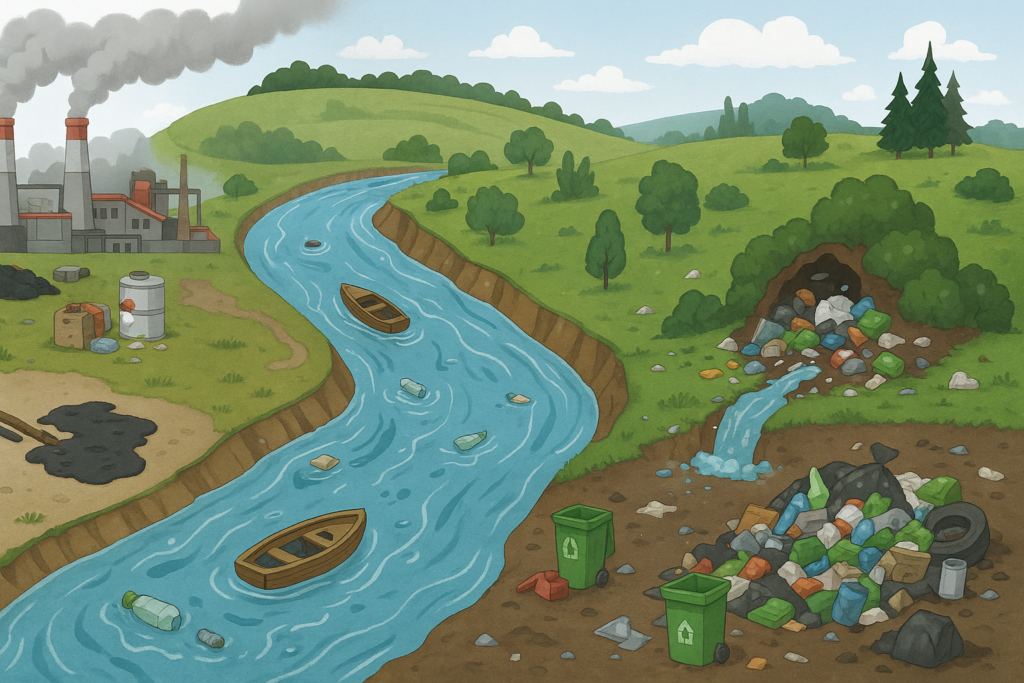Pollution represents one of the most significant environmental challenges of our time. It occurs when harmful substances contaminate the environment, causing adverse effects on ecosystems, wildlife, and human health. This article explores the fundamental aspects of pollution, including its primary types, sources, impacts, and potential solutions.

What Is Pollution?
Pollution is the introduction of contaminants into the natural environment that cause adverse change. These contaminants can be chemical substances, energy forms like noise or heat, or even biological organisms. When pollutants exceed the environment’s natural capacity to absorb and process them, pollution occurs.
Major Types of Pollution
Air Pollution
Air pollution occurs when harmful substances contaminate the air we breathe.
Common sources include:
- Industrial emissions from factories and power plants
- Vehicle exhaust from cars, trucks, and airplanes
- Agricultural activities, including livestock and fertilizer use
- Residential heating and cooking with fossil fuels
- Wildfires and controlled burning
Effects of air pollution:
- Respiratory diseases such as asthma and bronchitis
- Cardiovascular problems
- Reduced visibility (smog)
- Acid rain that damages buildings, forests, and water bodies
- Contribution to climate change through greenhouse gas emissions
Water Pollution
Water pollution involves the contamination of water bodies such as lakes, rivers, oceans, and groundwater.
Primary causes include:
- Industrial waste discharge
- Agricultural runoff containing pesticides and fertilizers
- Sewage and wastewater
- Oil spills and leaks
- Plastic waste
Consequences of water pollution:
- Reduced drinking water quality
- Destruction of aquatic ecosystems
- Harmful algal blooms
- Bioaccumulation of toxins in fish and other marine life
- Waterborne diseases affecting human populations
Soil Pollution
Soil pollution refers to the degradation of land through the accumulation of toxic compounds, chemicals, salts, or disease-causing agents.
Major sources include:
- Improper disposal of industrial waste
- Excessive use of pesticides and fertilizers
- Mining activities
- Landfills and waste disposal
- Oil and fuel leakages
Effects of soil pollution:
- Reduced soil fertility and agricultural productivity
- Groundwater contamination through leaching
- Disruption of soil ecosystems
- Potential health risks from consuming contaminated crops
- Land degradation and desertification
Noise Pollution
Noise pollution is excessive noise that disrupts the natural balance and human activities.
Common sources include:
- Transportation (roadways, airports, railways)
- Industrial operations
- Construction activities
- Entertainment venues
- Household appliances
Impacts of noise pollution:
- Hearing impairment
- Sleep disturbances
- Cardiovascular effects
- Decreased productivity
- Negative effects on wildlife behavior and reproduction
Global Impact of Pollution
Pollution transcends national boundaries and affects the entire planet:
- Climate Change: Air pollutants like carbon dioxide and methane contribute to global warming
- Biodiversity Loss: Pollution threatens numerous species and disrupts ecosystems
- Ocean Acidification: Increased carbon dioxide levels make oceans more acidic, threatening marine life
- Public Health Crisis: The World Health Organization estimates that pollution causes millions of premature deaths annually
- Economic Burden: Pollution-related healthcare costs and environmental remediation require significant resources
Solutions to Pollution
Addressing pollution requires comprehensive approaches at individual, community, national, and international levels.
Individual Actions
- Reduce personal energy consumption
- Choose public transportation, carpooling, or non-motorized transport
- Minimize waste generation and practice proper waste disposal
- Use environmentally friendly products
- Conserve water and reduce chemical use in homes and gardens
Community and Organizational Efforts
- Implement recycling and composting programs
- Develop green spaces in urban areas
- Support local environmental initiatives
- Promote environmental education
- Advocate for sustainable business practices
Governmental and International Actions
- Establish and enforce environmental regulations
- Invest in clean energy technologies
- Provide incentives for sustainable practices
- Monitor pollution levels and enforce compliance
- Participate in international environmental agreements
Technological Solutions
- Develop and implement cleaner production technologies
- Advance renewable energy systems
- Create improved waste treatment and recycling methods
- Design energy-efficient buildings and transportation
- Innovate in sustainable agriculture practices
Summary
Pollution presents a complex challenge that affects all aspects of our environment and society. Understanding its causes, types, and impacts is essential for developing effective solutions. By combining individual actions, community efforts, governmental policies, and technological innovations, we can work toward reducing pollution and creating a healthier, more sustainable world for current and future generations.
The path to addressing pollution is neither simple nor short, but with continued awareness, commitment, and collaboration, significant progress is possible in mitigating its harmful effects and protecting our planet’s natural systems.